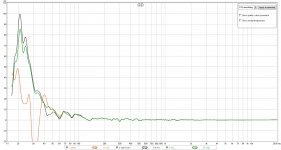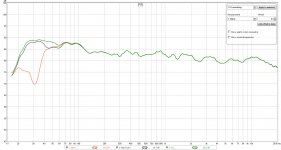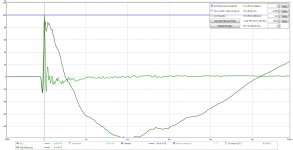The DSP should be able to do your XO much better than a plate amp - you are new with it so may take some time to learn. 4th order adds group delay - you can try 2nd or 3rd in miniDSP and see if the GD goes down even more.
The DSP should be able to do your XO much better than a plate amp - you are new with it so may take some time to learn. 4th order adds group delay - you can try 2nd or 3rd in miniDSP and see if the GD goes down even more.

This is the mains response. I had to marry the sub to this. I am not using the DSP to affect the mains or the sealed subs at all.
I tried 2nd order slopes and they screwed up the FR in the 50-100hz range. I did try them, and with several XO points.
That is a really steep cliff on the mains at 50Hz - is there a high pass filter somewhere? A bass reflex usually falls of at 12dB/oct. Try moving XO point up to 80Hz, 40Hz is a very low XO point and your subs should work well up to 100Hz even.
That is a really steep cliff on the mains at 50Hz - is there a high pass filter somewhere? A bass reflex usually falls of at 12dB/oct. Try moving XO point up to 80Hz, 40Hz is a very low XO point and your subs should work well up to 100Hz even.
The cliff is at 40hz actually. No filters on the mains. The "cliff" is a SBIR room issue. The mains are about 8' from the front wall.
I did try moving the XO up higher. All the overlap with the mains created a definitive bulge from 40hz to just beyond wherever I set the XO point.
https://www.gearslutz.com/board/studio-building-acoustics/817205-my-listening-room.html
Here is a link to a thread that covers how my room evolved. I dont blame you if you dont want to read it, for it is long. But some of your questions may be answered there.
Last edited:
At least at the level they were calibrated at. I have seen some comments (from professionals) that say this is the only place the cal holds on our cheap plastic diaphram but i have yet to find any technical back-up.
Which "professionals" are you referring to? References? Links? Otherwise what you write is just FUD.
The new theoretical best is lower and quite a good number: 6.25ms at 40hz and 10ms at 30Hz
Ive been playing with the DSP and learned a few things.
I CAN get close to your theoretical numbers, but I have to sacrifice lots of magnitude in the low end to get there.
I downloaded and tried the 2.1 advanced plugin. I wasn't able to get things any better overall.
The reason (I think) the plate amp XO works better is because I cant take it out of the signal path completely. No bypass. I can turn it up to 180hz, but its still there. Using the DSP XO is in effect adding a secondary filter slope which causes more problems than it solves.
You're doing well, but how does it sound?
Very nice!
The bass has notably tightened up some. Since I have already done extensive room treatment, I don't think any further improvement is possible without replacing all the subs and amps. Something that may happen some day, but not today.
Mostly, I created this thread to work out how closely GD corresponds to tight sounding bass. There is a correlation. Not the only factor though.
What does your impulse response look like? Click on "Step Response" and see what that looks like. If you can adjust all the time delays to get something like this - it will go from good to great (or extraordinary sounding tight bass).
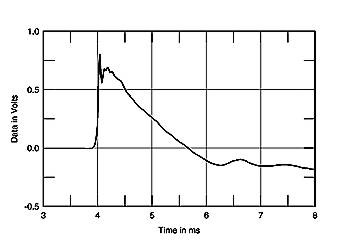
Measuring Loudspeakers, Part Two Page 2 | Stereophile.com
Here is SR and IR from my speaker - and when I got this - it knocked my socks off:
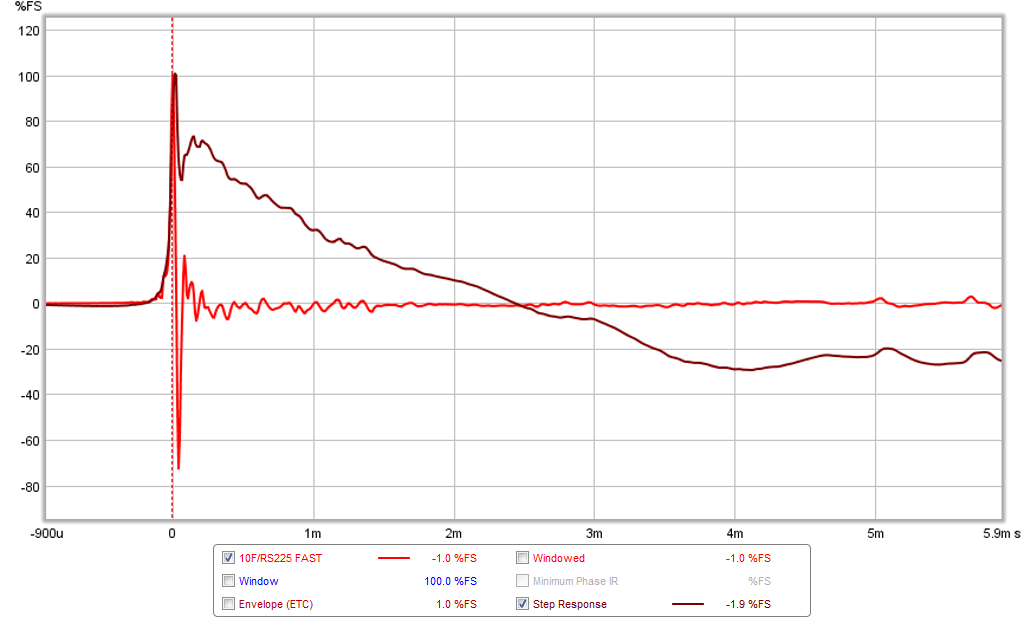

Measuring Loudspeakers, Part Two Page 2 | Stereophile.com
Here is SR and IR from my speaker - and when I got this - it knocked my socks off:

Another question here.
Those theoretical GD's, I assume they are based on a FR response targeted to be flat?
Would they naturally be higher if one is targeting +5db in the bass region?
Those theoretical GD's, I assume they are based on a FR response targeted to be flat?
Would they naturally be higher if one is targeting +5db in the bass region?
GD is based on derivative of frequency response - so it can be tilted but not curved. Flat as in level is not required for low GD.
For the step response, you have a large negative overshoot at 2ms. I think that means that there could be better time alignment between your tweeter and your mids. But it actually looks pretty good - Wesayso knows more about this maybe he can suggest how to improve.
For the step response, you have a large negative overshoot at 2ms. I think that means that there could be better time alignment between your tweeter and your mids. But it actually looks pretty good - Wesayso knows more about this maybe he can suggest how to improve.
GD is based on derivative of frequency response - so it can be tilted but not curved. Flat as in level is not required for low GD.
For the step response, you have a large negative overshoot at 2ms. I think that means that there could be better time alignment between your tweeter and your mids. But it actually looks pretty good - Wesayso knows more about this maybe he can suggest how to improve.
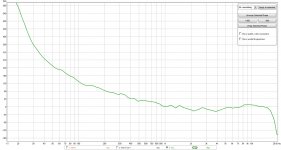
If I am reading my phase graph right, the frequencies in the 2-4K range arrive slightly before the rest. The Tweet/Mid XO (LR2) is around 2800hz.
The tilt vs curve makes sense. Hard to do though. Especially for someone like me who refuses to use processors on the mains.
Last edited:
I've never seen such a step response (or group delay) and phase behaviour from a second order speaker before. If this were a commercial design it would cost mayor dollars I'm sure. More proof Troels knows what he's doing. It looks very well behaved in time domain and your room seems excellent!
2 ways to go forward. One would mean using active (FIR) filtering (I bet it would be awesome!) and the other would mean to pick speakers with even lower order filters (or no filters at all)
I'll let Troels explain the draw back from second order filters: Siri's Killer Note
So basically, there would/could still be small errors in harmonics. Troels seems like a very wise man indeed, knows what he is doing.
And you made an excellent room for these speakers. I bet even Troels would be proud to see these graph's.
Just to indulge me, could you show a Group Delay plot gated 20 ms? Just curious.
Too bad you wouldn't want to try active filters, just for fun! 😉
Seems to me your speaker and room are up for the challenge. Any pictures to share of the room/speakers?
One more question: if you close your eyes while listening, is this a "They are here" or "You are there" kind of sound? In other words, do you get the impression the musicians are in the room with you or are you virtually transported to the actual event.
2 ways to go forward. One would mean using active (FIR) filtering (I bet it would be awesome!) and the other would mean to pick speakers with even lower order filters (or no filters at all)
I'll let Troels explain the draw back from second order filters: Siri's Killer Note
So basically, there would/could still be small errors in harmonics. Troels seems like a very wise man indeed, knows what he is doing.
And you made an excellent room for these speakers. I bet even Troels would be proud to see these graph's.
Just to indulge me, could you show a Group Delay plot gated 20 ms? Just curious.
Too bad you wouldn't want to try active filters, just for fun! 😉
Seems to me your speaker and room are up for the challenge. Any pictures to share of the room/speakers?
One more question: if you close your eyes while listening, is this a "They are here" or "You are there" kind of sound? In other words, do you get the impression the musicians are in the room with you or are you virtually transported to the actual event.
Last edited:
View attachment 484008
If I am reading my phase graph right, the frequencies in the 2-4K range arrive slightly before the rest. The Tweet/Mid XO (LR2) is around 2800hz.
The tilt vs curve makes sense. Hard to do though. Especially for someone like me who refuses to use processors on the mains.
Jim1961,
I have to say that if this is your phase plot from listening position - it is one of the best I have seen. This means you have a fantastic sounding system and room any recording studio would be proud to own. It also means you really know what you are doing and have eeked every little last bit of performance out of it. Can we get a photo of your setup so we can all admire what audio nirvana looks like? 🙂
Congratulations! I am not sure you can do much more other than go to DSP DRC and FIR!!! 😀

I just followed the link to your thread on gearslutz.com. It confirms everything I was thinking. Well done! So I've seen what audio nirvana looks like X 😉. You can too, just follow the link Jim provided earlier: https://www.gearslutz.com/board/studio-building-acoustics/817205-my-listening-room.html
I'm impressed! Something I'll never achieve in my home (at least not if I want to keep my family close 😉), but I'll keep trying to get as close as possible using the other approach: heavy DSP on the mains (lol).
My speakers don't have crossovers, I'm still of the opinion that a speaker without crossovers (or one using shallow first order slopes) keeps even more of the ambience of the recording alive. So far I haven't been disappointed by that journey.
I did notice a few over on gearslutz did a virtual audition of your room by means of convolving your IR. I'll have to try listening to your room that way. It's a fun way to get an impression without actually being there.
I'm impressed! Something I'll never achieve in my home (at least not if I want to keep my family close 😉), but I'll keep trying to get as close as possible using the other approach: heavy DSP on the mains (lol).
My speakers don't have crossovers, I'm still of the opinion that a speaker without crossovers (or one using shallow first order slopes) keeps even more of the ambience of the recording alive. So far I haven't been disappointed by that journey.
I did notice a few over on gearslutz did a virtual audition of your room by means of convolving your IR. I'll have to try listening to your room that way. It's a fun way to get an impression without actually being there.
Ahh... Jim's room is maxed out with treatment 🙂
It is quite impressive what can be achieved with speakers with passive higher order cross overs. TG's designs certainly are very good. Gives me something to look forward to if I ever go for the Discovery 3-ways.
It is quite impressive what can be achieved with speakers with passive higher order cross overs. TG's designs certainly are very good. Gives me something to look forward to if I ever go for the Discovery 3-ways.
It may be even more impressive to see what a room can do! (or DSP 😉).
So many people focus on the speaker. Yet here we have (a good speaker) an example of what a room can do.
Jim, I'm kind of glad you got lost here and posted on this side of the forum. I may have missed the nice read if it had been posted in multi way.
Maybe some time soon we might have something for you to try (no, don't worry, not DSP). First we must find out if it actually works.
I could ask you if you're happy with the sound you got out of this exercise. But judging the other thread would tell me you are never done.
So many people focus on the speaker. Yet here we have (a good speaker) an example of what a room can do.
Jim, I'm kind of glad you got lost here and posted on this side of the forum. I may have missed the nice read if it had been posted in multi way.
Maybe some time soon we might have something for you to try (no, don't worry, not DSP). First we must find out if it actually works.
I could ask you if you're happy with the sound you got out of this exercise. But judging the other thread would tell me you are never done.
- Status
- Not open for further replies.
- Home
- Loudspeakers
- Full Range
- Group Delay Questions and Analysis

